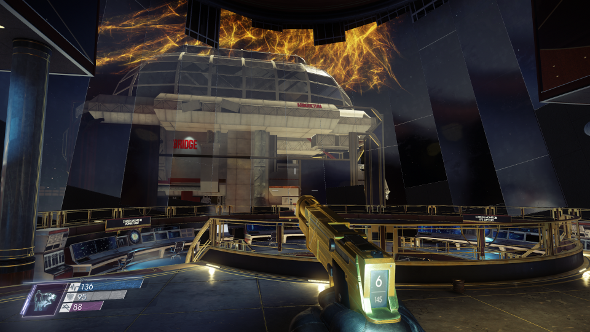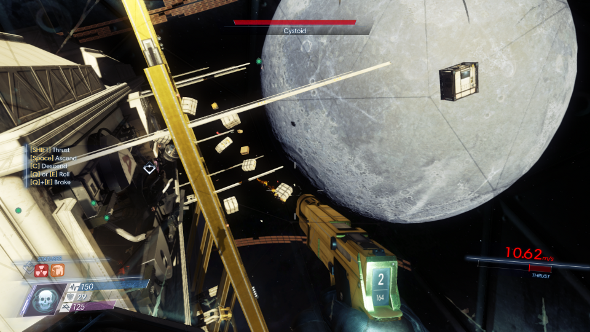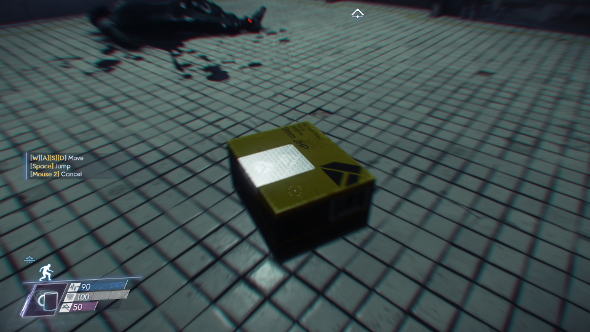
Prey’s Talos 1, an art-deco house station hanging within the black like a gleaming obelisk, is suffering from baseball gloves. No matter the place you go, they’re scattered round: floating by way of the zero-G chambers, plonked on desks, and shoved within the pockets of Talos 1’s murdered inhabitants.
If you want your galactic adventures minus the specter of floating props, take a look at our record of the best space games.
Developers Arkane admit they obtained carried away with catching mitts, a prop devised by lead surroundings artist Eric Beyhl, who simply occurs to be an enormous baseball fan. The staff in control of set-dressing cherished them they usually ended up completely in all places. In reality, they’re so prolific that you simply would possibly count on to stumble throughout an enormous baseball stadium buried someplace deep inside the house station. Still, Arkane made it work.
“We started trying to figure out what sort of story we were telling with this,” lead designer Ricardo Bare tells me. “It [had something to do with game designer] Steve Powers, the man who was liable for taking good care of the character database. One of the characters is on the gross sales staff. In the foyer, there’s a gross sales workplace, and people guys take briefcases filled with neuromods, load them onto a shuttle, and fly right down to Earth to promote them to wealthy clientele. One of those guys is an ex-professional baseball participant.

“You’ve most likely heard the story of ‘What did the ex-professional football player do? Well, he became a car salesman’. It’s that kind of deal. This man washed out of the foremost leagues and obtained a job as a salesman for TranStar. But when he joined the corporate, he had packing containers and packing containers of signed baseball gloves, so he simply handed them out as presents to all the staff on the house station. There’s all these journal entries the place he’s unhappy as a result of folks don’t appear that enthusiastic about his baseball gloves. It type of exhibits that while you’re creating artwork, you possibly can unintentionally inform humorous tales that add quite a lot of humour and depth to the sport.”
Baseball gloves in Talos 1 are emblematic of how videogames are made – how issues change over the course of growth, and the way a tiny element can alter one other side of the completed product. This is a prop that was initially simply alleged to humanise the residents of Talos 1 with a slice of residence, nevertheless it ended up including meat to the story, too. Prey wasn’t all the time going to be set on an area station, however Arkane had one rule throughout the idea section: the sport have to be a self-contained surroundings, not a collection of missions. Arkane needed gamers to really feel trapped. They needed gamers to grow to be intimate with a spot that slowly evolves as they play.
“We had some ideas inspired by other movies or books that we’d read, things like ‘What if it was a fake city?’” Bare remembers. “The other thing we wanted to do is something where you think ‘this is the truth’, but ‘Surprise! This is actually the truth’. Lots of little twists and turns like that. Our idea was ‘What if it’s like a fake city that’s almost an ant farm for humans, and it’s being curated by some aliens?’ We had another idea that was like Lost, set on an island that’s super mysterious, and you’re not sure why you’re there or what’s going on. It wasn’t even a long [decision process]. Very quickly, we decided ‘Hey, let’s have the structure of Arx Fatalis, but we’re all huge fans of System Shock, so let’s do something like that.’”

The finish consequence takes the construction of Arkane’s Arx Fatalis and plonks it within the claustrophobic house setting of System Shock, Looking Glass’s sci-fi RPG. Publishers Bethesda have been sitting on the Prey model, following the cancellation of Prey 2, and so determined that Arkane ought to use the identify for his or her sport.
Despite Prey having nothing to do with the Human Head Studios’ authentic, some small story particulars have been switched up. For instance, your brother, Alex Yu, was initially going to be a buddy from school. January, an AI that was to be primarily based by yourself persona, was known as Danielle, and had a a lot bigger function. In the next prototype, January wasn’t even primarily based on Yu’s persona – it was simply an AI with unknown intentions. Then the staff determined to make protagonist Morgan Yu mute, so the choice was made to make these machines a cipher for his persona, transferring his voice onto the AI. It could sound like an existential nightmare, nevertheless it turned out to be the proper compromise.
Arkane needed to keep away from having moments the place Yu was saying issues that the participant wouldn’t join with, so this answer allowed them to have the most effective of each worlds. There’s loads of character elsewhere aboard Talos 1, in any case. To give the station a very lived-in really feel, for instance, Arkane created NPC residents, each those that survived the outbreak of the Typhon alien kinds, and people who didn’t. Some of them at the moment are phantoms, roaming the station as shadows. Recently deceased or in any other case, each NPC is necessary – the participant can observe each considered one of them through a safety terminal to find their destiny. It’s an expansive solid – Arkane created round 250 of them.

“We already had this system in development where you were going to be able to use security computers to find certain quest-related people,” Bare remembers. “I think it was our late level designer Rich Wilson who suggested: ‘Why don’t we just apply that globally? Instead of having dead generic corpses.’ We already had this system where you could log into a computer and find doctor so-and-so, so why didn’t we just list everyone? And instead of being super explicit and scripted, the player can ‘opt-in’ to using that system at any time. Anytime the game asks them to find somebody or when they want to find somebody. That system just populated the names onto the corpses, basically. One of our local designers, Steve Powers, who’s really good with narrative stuff, curated that list. He came up with all the names of every person, and they all have varying levels of detail to them depending on how much time the player was going to spend on that person.”
To make monitoring these folks down rewarding, Arkane used intelligent environmental storytelling together with audio logs. In Prey, although, props are much more necessary than typical.
“From an art perspective, there’s already a kind of ‘studio’ culture with it, because one of the things the team in Lyon does really well is environmental storytelling,” artwork producer Jessie Boyer explains. “They try to imagine what the people would be doing on their daily routes. For us, we already had intentions of doing that, so it wasn’t a stretch to take that to the next level. When we were trying to imagine the people, it actually helped to have that roster system. I could just go to Steve, Rich, or Ricardo and be like ‘Hey, what kind of hobbies does this person have?’ and we could really tell a story with the props we had available to us.”

The staff had numerous conferences about this, discussing how many individuals would feasibly work on an area station the dimensions of Talos 1. They tackled every division, from engineering to the science labs, determining how many individuals labored there, earlier than selecting the entire quantity NPCs. From there, they gave every character a job description. Later within the sport you discover out that station volunteers are being murdered by Mimics so as to create ability-giving neuromods – Arkane even took that into consideration when inserting neuromods on the earth, determining what number of made sense and even noting how a lot cash TranStar, the company behind all of it, had made. The growth staff tracked this data by way of infographics, a few of which may be discovered hidden round Talos 1.
This consideration to element in making the inhabitants of the station really feel human, and the station itself really feel lived in, is unparalleled. A standout second sees you stumble throughout the sleeping pods of a number of the station’s residents. In every, you discover little particulars about their lives: pictures from again residence, notes, kids’s drawings, and extra – for added authenticity, these drawings have been made by the kids of Arkane staff. These small particulars are utilized in mixture with greater tales to make the residents of Talos 1 – even the lifeless ones – come alive.
Among many memorable discoveries, there’s a love story that develops between two girls, which you get to observe to its heartbreaking conclusion. One of the ladies within the story is Danielle, the prototype AI, repurposed for a brand new story. And you see a Dungeons & Dragons-style pen and paper RPG, that was being performed by the Talos 1 workers, unfold as you journey between the totally different departments.

“The D&D game was fun, because the Crew Facilities was one of my favourite levels. Rich Wilson worked on it,” Bare tells me. “That degree’s nice as a result of it’s probably the most humanising areas within the sport. Lots of people pitched in with methods to floor everybody’s lives with actual particulars. What do they eat? What do they do for enjoyable? They’re not all the time in a laboratory pouring fluids into beakers or dissecting aliens. They need to blow off some steam and hang around. They develop relationships.
“We needed the crew quarters to symbolize that human, unscripted aspect of their lives. One of the concepts was ‘What if the five of them played tabletop games in the rec center?’ We had audio logs of their gaming classes, and later Rich tried to tie that into the search to seek out all of Danielle’s voice samples, so she turned any person who was a part of the sport. If you’re looking for Danielle’s voice samples, you come upon the gaming session that she’s part of, and by the way you study all these different characters. It’s a little bit of an allusion to Arx Fatalis, as a result of the roleplaying sport they’re enjoying is known as Fatal Fortress, which is simply English for ‘Arx Fatalis’.”

Storytelling is all very properly, however Arkane’s mastery is additional demonstrated by the truth that the location of those storytelling instruments additionally serves a gameplay function in Prey. Mimics can morph into these things and spring a entice, as can the participant in the event that they determine to make use of neuromods. It’s a recipe for paranoia.
“Later in the game, artists would deliberately put two or three of something next to each other just to smoke the player out,” Bare laughs.
“There’s one character that has dementia,” provides Boyer, “so at one point we made sure to place a lot of cups and a lot of notepads in a room, like he was constantly forgetting where he was putting his stuff. Little things like that could unintentionally build some tension in this dark corner that’s full of cups [laughs].”
To be certain that there have been no less than /some/ guidelines gamers might acknowledge, Arkane determined that Mimics might solely grow to be props that have been no smaller than a espresso cup, and no greater than an workplace chair. This made environments extra readable, guaranteeing you wouldn’t crap your pants strolling previous a fridge.
Still, that paranoia stays. It’s a masterful marriage between sport mechanics and storytelling. What higher method is there to make a participant take discover of the work that’s gone into environmental storytelling than to make them scared that the props would possibly homicide them? In doing so, Arkane ensures gamers are scanning each room rigorously, being attentive to all of the small particulars, and praying that each baseball glove they discover received’t out of the blue flip sentient and attempt to eat their face like a rubbery facehugger.
Source

